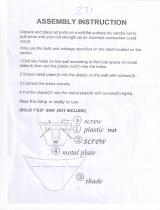
Instructions for Use10
Continuous Operation of the Cooling
System
• The door was frequently opened or it was
left opened for too long.
• The door is not properly closed (the door
may sag, the gasket may be polluted or
damaged).
• Perhaps you have overloaded the
appliance with fresh foods.
• The reason may be inadequate ventilation
of the compressor and condenser (assure
adequate air circulation and wipe off the
condenser).
Ice Formation on the Inner Rear Wall
As long as the defrost water runs to the
channel and through the outlet to the drain
pan on the compressor, automatic
defrosting of the appliance is assured.
In case the ice formation on the inner back
wall is increased (3-5 mm), ice should be
manually defrosted.
Set the thermostat knob to STOP position
and leave the door open. Never use electric
devices for defrosting and do not scrape the
ice or frost layer with sharp objects.
After completed defrosting, turn the knob to
desired position and close the refrigerator
door.
The cause of increased ice formation may
be one of the following:
− the door does not seal well (clean the
gasket if it is contaminated, or replace
it if it is damaged);
− the door was frequently opened or it
was left opened for too long;
− the food stored in the refrigerator was
warm;
− the food or dish is touching the inner
back wall.
Water is Leaking From the Refrigerator
In case the discharge water outlet is
clogged, or the defrost water drips over the
channel, water leaks from the refrigerator.
• Clean the clogged outlet, for example with
a plastic straw.
• Manually defrost the increased ice layer.
See Ice Formation onthe Inner Rear Wall.
Noise
Cooling in refrigerating-freezing appliances
is enabled by the cooling system with
compressor, which produces noise. How
noisy the appliance is depends on where it
is placed, how it is used and how old the
appliance is.
• During the operation of the compressor
the noise of liquid is heard and when the
compressor is not operating, the
refrigerant flow is heard. This is a normal
condition and it has no influence
whatsoever on the lifetime of the
appliance.
• After starting the appliance, the
operation of the compressor and the
refrigerant flow may be louder, which
does not mean that something is wrong
with the appliance and it has no influence
on the lifetime of the appliance. Gradually
the noise is reduced.
• Sometimes unusual and stronger noise
is heard, which is rather unusual for the
appliance. This noise is often a
consequence of inadequate placing.
− The appliance shall be placed and
levelled firmly on solid base.
− It should not touch the wall or kitchen
units standing next to it.
− Check the accesories in the interior of
the appliance, they should be placed
correctly in their positions; also check
the bottles, tins and other vessels that
might touch each other and rattle
Bulb Replacement
Before replacing the light bulb, disconnect
the appliance form the power supply.
Insert the screw driver into the bulb cover
opening on the lower side and with slight
push downward remove the cover. Replace
the old bulb with a new one – halogenous or
standard (E 14, max. 25 W - Osram
Halolux, Philips H.E.) and fit back the cover.
Light bulb is consuming good therefore
our in-guarantee service does not relate
to it.
Bulb lamps used in this appliance are
special purpose lamps selected for
household appliances use only. They are
not suitable for household room illumination.












